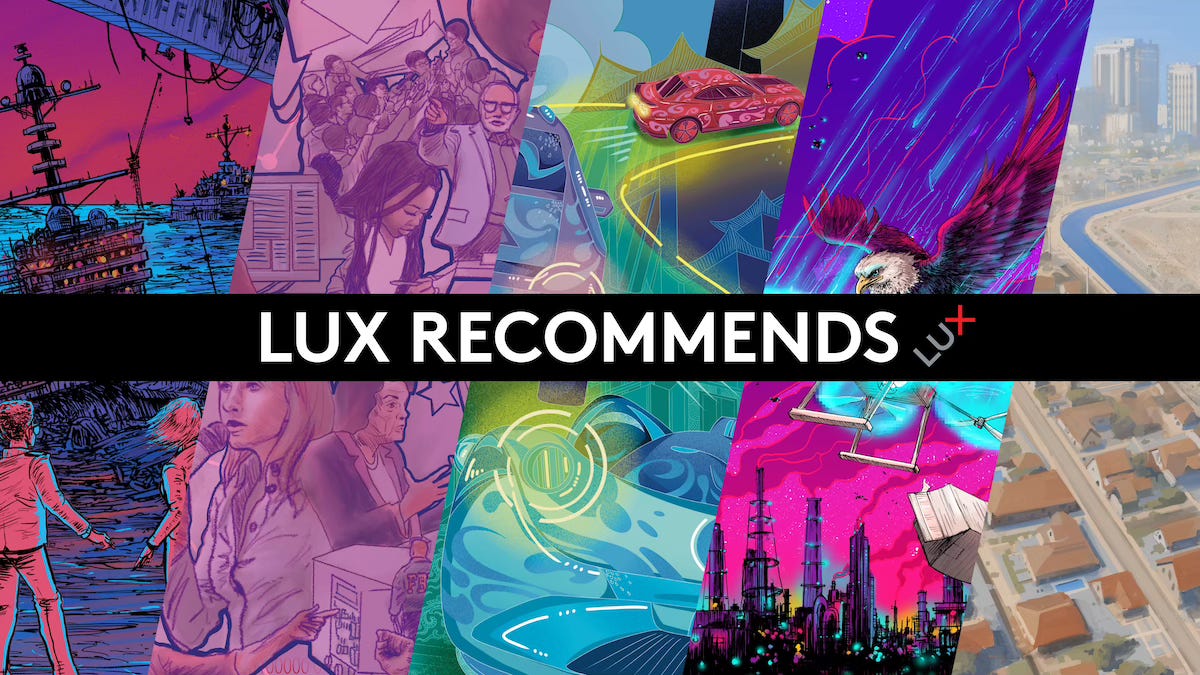Israel’s assault was bravura without bravado
Plus cinnamon, beauty, and LLM smackdown: Lux Recommends #462
A brief note on Israel’s attack on Iran; plus, rare earths as cinnamon, rethinking “classic” architecture, and what happens when you pit LLM against LLM.
Israel’s assault was bravura without bravado
Like me, you’re probably spending much of today drinking from the firehose of open-source intel emanating from Iran. As I write this brief note on Friday morning, Israel’s overnight strike on the Islamic Republic appears to have been comprehensively successful, eliminating critical functions of the Iranian military while also assassinating a bevy of its senior leaders, including Hossein Salami, the head of the country’s Islamic Revolutionary Guard Corps.
The question that’s been coursing through my group chats is this: Could the United States have pulled off an operation like this? My answer is mostly no, and it’s because we lack the organizational strength to make carefully calibrated judgments about complex risks under immense uncertainty.
Israel’s assault was bravura without bravado. Consider the depth of intelligence the government would have had to consume and integrate to underpin its assault. Israel had to precisely identify the location and strength of Iran’s hardened nuclear facilities, including the one at Natanz, alongside its air defenses and other fixed military assets. It then had to persistently track the country’s fighter jets and other mobile equipment, even as the Iranians no doubt feigned movements of these units over time. Meanwhile, Israel had to simultaneously monitor — in real-time — the locations of a kill list of top figureheads, people who strenuously work to protect themselves from assassination.
It’s one thing to have good intel, but another to build an integrated plan to use it. Operationally, Israel had to hit all of its targets within a very tight window using a variety of means, from precision missiles to what appears in open-source intelligence and some early news reporting to be custom drone swarms built and deployed by undercover intelligence operatives on Iranian soil.
Even at these earliest phases, the United States falters. An overwhelming focus on signals intelligence (SIGINT) over on-the-ground sourcing means that we are often completely out-of-date on what is really happening and what to strike. Take the Houthis in Yemen, where more than $1 billion of American defense dollars were spent in an operation for no positive result whatsoever.
Let’s say you have the intel and build the plan. The truly difficult step is making the decision to go forward under immense uncertainty. Even with the best intelligence networks, information can quickly become out-of-date. How much uncertainty does Israel have that it identified every last nuclear enrichment facility? How much uncertainty does it have about the supposed locations of Iran’s leaders? What about the uncertainty around the operation itself? Things go wrong in battle, and what are those consequences and can the country recover from them? What will be Iran’s response in the aftermath of a successful or failed operation?
For all of the commentary asserting Israeli Prime Minister Benjamin Netanyahu attacked Iran to distract from the near-collapse of his government the day before in the Knesset, the reality is that a meticulous operation like this simply can’t be improvised on a political whim. Like last year’s beeper operation against Hezbollah (listen to our podcast with Nick Reese to learn more), I am sure we will learn that this operation was months — really years — in the making.
The patient but precise planning required for an operation of this magnitude feels like the Achilles’ heel of America’s political and national security system. We have a tough time aggregating risks and uncertainties and then adjudicating among them. We very rarely have the patience required for precision since America is used to failures without consequence. If we attack the Houthis and miss (and, again, we really did miss) — what happens? They just keep on bombarding ships in the Red Sea as they have been for months. If Israel attacks Iran and misses a missile launch site or a nuclear enrichment facility, that could be the end of the nation.
I see much bravado on social media around this attack, but my humble rejoinder is that I guarantee you Israel’s leaders were beyond stressed throughout this operation. I picture a scene not unlike the iconic photo of the Obama national security team staring at an unseen television screen during the raid on Osama bin Laden, perhaps the best example of patient and persistent precision we’ve seen from America’s military in the modern era. The die must be cast sometimes — but can we accept its consequences? The challenge with uncertainty is that we don’t even know what those consequences might end up being. In the Middle East, at least, we are about to find out.
From Lux Capital
This week, Josh Wolfe joined on ChinaTalk to discuss the tech right, immigration, R&D and even parenting. Listen below.
Lux portfolio company Nominal is announced its $75 million Series B funding round with our participation, while Anduril closed a new $2.5 billion round at a $30.5 billion valuation. Tim Andrews, who received a pig kidney transplant thanks to advancements made by eGenesis, is thriving; on Wednesday, he threw out the first pitch for the Red Sox at Fenway Park. Lux led the $191 Million Series D last year.

From around the web
1. The spice of life
The most popular analogy in discussions of rare earths is to oil. But does that comparison hold up — or point to any realistic solutions to the United States’ rare-earths problem? Laurence directs you to a recent post in
, in which Lucy Hornby proposes cinnamon as an apter parallel.Back to the cinnamon analogy. We can build strategic stockpiles of tree trunks, but then we’d have to create a whole supply chain of grinders, driers, processors, little glass bottles, plastic bottle caps, etc to commercialize it to the various forms in which consumers want to add cinnamon to their baking process, whether the end product is chicken tagine or gingerbread cake or pumpkin spice latte.
In other words, we treat rare earths like a trade problem that can be solved by stockpiling … but really, it’s a problem of 1> mining and geology; 2> trade quotas and price arbitrage; 3> very complex industrial value-added chains...
2. 404: Runway not found
In my piece on vibe coding earlier this week, I mentioned a compilation by FlightAware’s Ben Burwell of falsehoods programmers believe about aviation. It’s a great case study in the futility of expecting AI-generated code to “understand” things even humans don’t. Among other fallacies, Ben flags:
Flights depart from a gate
Flights that depart from a gate only leave their gate once
Flights depart within a few hours of the time they were scheduled to
Flights depart within a day of the time they were scheduled to
Flights have schedules
Flights take off and land at airports
Flights are at most a dozen or so hours long
Okay, they’re at most a few days long
3. Love symbol, hate typing
For the curious, scientist-in-residence Sam Arbesman recommends reporting by Brian Feldman in New York Magazine about the trials of writing about Prince after the musician changed his name to the “love symbol” in 1993.
The Love Symbol proved frustrating for people who wanted to both speak and write about Prince. Writers, editors, and layout designers at magazines and newspapers wouldn’t be able to type the actual name of the Artist Formerly Known As Prince. So Prince did the only thing you could do in that situation: He had a custom-designed font distributed to news outlets on a floppy disk.
4. Modern marble
Editor Katie Salam liked ’s reevaluation of the purpose and value of beauty in the architecture of the Belle Époque period (be sure to check out our podcast interview with him about his recent book on Margaret Mead).
Today, buildings like the Palace of Fine Arts tend to be lauded as examples of a “traditional” or “classical” aesthetic that modernity supposedly abandoned. …But to someone living at the time they were built, like Henry Adams, these sorts of buildings were the ultimate product of technological modernity. They were something close to post-modern pastiche — a society reveling in its distinctly un-traditional ability to smash different elements of the past together into forms aggressively new.
5. Large language Machiavellis
Which AI model would win in a battle of wits and strategy? To find out, Alex Duffy at Every developed “AI Diplomacy.” The game pits different LLMs against each other in a reimagining of the classic game Diplomacy, which centers on the great powers as they try to take over Europe. The results have much to reveal about our favorite chatbots. H/t Laurence.
Watching R1 lean into role-play, OpenAI’s o3 scheme and manipulate other models, and Anthropic’s Claude often stubbornly opt for peace over victory revealed new layers to their personalities, and spoke volumes about the depth of their sophistication. Placed in an open-ended battle of wits, these models collaborated, bickered, threatened, and even outright lied to one another.
6. Vietnam’s development path shattered?
Finally, I’ll direct your attention to an important analysis in the Financial Times, centered on the intricate supply chains that Vietnam built up over the past few decades which are now under fire in the tariff war between the United States and the rest of the world.
“We got the message from President Trump, and it kind of continued under President Biden . . . the signal was ‘China bad, Vietnam and other countries, good’,” says founder Steve Greenspon. “So when the large tariff was announced for Vietnam, it was crushing.”
Honey-Can-Do has cut costs and let go of employees in the US due to the tariff uncertainty, and Greenspon says its suppliers in Vietnam may resort to the same measures to save costs.




The Israeli army has managed to build an impressive tolerance for risk and high stakes operations. It appears they also have the tactical skills to make it all happen. That’s quite different than the “don’t lose” mentality I’ve seen in a lot of organizations around these parts. A lot of that tolerance presumably comes from decades of being up against the wall with existential threats.
The question then becomes how do we learn from their operational and risk mindset without the same outside pressures? Is that even possible if you start from a position of strength that you’re not willing to put at risk? In short, are we at a local maximum afraid to drop into the valley to find the true maximum?